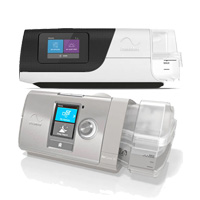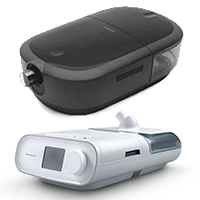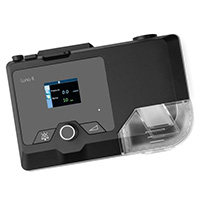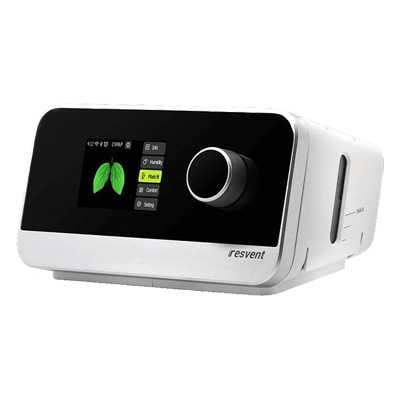Do you have questions regarding your ResMed AirSense/AirCurve, Philips Respironics DreamStation, or ReactHealth/3B Luna devices? Look no further! Click your device below and you will find user manuals, helpful videos, and more!
We understand that getting used to your PAP therapy and using your machine nightly can be a challenge. We have compiled some items that might help you along in your journey to a better night's sleep:
Helpful Tips for PAP Use | Contact a Sleep Coach
Helpful tips for PAP use.
Trouble getting used to wearing the CPAP device: First, try wearing just the CPAP mask for short periods of time while you're awake — for example, while watching TV. Then, try wearing the mask and hose with the device turned on during the day while you're awake. Once you get used to how that feels, start using the CPAP device every time you sleep — including naps. Just wearing the CPAP device every now and then may delay getting used to it.
Difficulty tolerating forced air: You may be able to overcome this by using a machine with a "ramp" feature. This setting allows you to start with low air pressure. The machine then automatically and slowly increases the air pressure to your prescribed setting as you fall asleep. If this feature doesn't help, talk with your doctor
Dry or stuffy nose: Check to make sure your mask fits well. A leaky mask can dry out your nose. If you must tighten straps often to prevent air leakage, the mask may not fit properly. You can also adjust the level of humidification. Using a nasal saline spray at bedtime can also help ease a dry, stuffy nose.
Feeling claustrophobic: Practice using your mask while you're awake. First, just hold it up to your face without any of the other parts. Once you're comfortable with that, try wearing the mask with the straps. Next, try holding the mask with the attached hose on your face, without using the straps. Turn on the CPAP machine, perhaps with the ramp feature turned on. Next, do this using the straps too. Finally, try sleeping with the mask and machine on. Relaxation exercises, such as progressive muscle relaxation, watching TV, or reading may help reduce anxiety related to CPAP use. If you're still feeling claustrophobic, it may help to get a different size mask or try a different style, such as one that uses nasal pillows.
Leaky mask, skin irritation, or pressure sores: A leaky or an ill-fitting mask means you're not getting the full air pressure you need, and you may be irritating your skin. The mask can also blow air into your eyes, causing them to become dry or teary. Try adjusting pads and straps to get a better fit. If the cushion fits over your nose, make sure it doesn't sit too high on the bridge of your nose, which can direct air into your eyes. Also, make sure to wash your cushion/pillows daily. If you develop skin deterioration or sores, such as on your nose, tell your doctor promptly.
Difficulty falling asleep: Wearing the mask alone for some time during the day may help you get used to how it feels and make it easier to fall asleep at night. Using the ramp feature that slowly and gradually increases the air pressure to your prescribed pressure setting as you fall asleep may make you more comfortable at bedtime. Following good general sleep habits also are helpful. Exercise regularly and avoid caffeine and alcohol before bedtime. Try to relax. For example, take a warm bath before you go to bed. Don't go to bed until you're tired.
Dry mouth: If you breathe through your mouth at night or sleep with your mouth open, some CPAP masks may worsen dry mouth. A chin strap may help keep your mouth closed and reduce the air leak if you wear a nasal mask. A full-face mask style device that covers your mouth and nose also may work well for you. The heated humidifier also may help.
Unintentionally removing the CPAP mask during the night: It's normal to sometimes wake up to find you've removed the mask in your sleep. If you move a lot in your sleep, you may find that a full-face mask will stay on your face better. You may be pulling off the mask because your nose is congested. If so, ensuring a good mask fit and using the heated humidifier may help. A chin strap also may help keep the device on your face. If this is a consistent problem, consider setting an alarm for some time in the night, to check whether the device is still on. You could progressively set the alarm for later in the night if you find you're keeping the mask on longer.
Bothersome noise: If you find your device noise is bothersome, first check to make sure the device air filter is clean and unblocked. Something in its way may worsen noise. If this doesn't help, call us to check the device to ensure it's working properly. If the device is working correctly and the noise still bothers you, try wearing earplugs or using a white noise sound machine to mask the noise. Placing the machine as far away from the bed as possible also may help make any machine noise less noticeable.
Too much water in tubing or mask: This can happen when there is too much condensation in tubing. Make sure the water chamber isn’t overfilled. Either turn the humidity level down or turn your tube temperature up. Make sure the correct end of tubing (the one with the electrical connection) is plugged into machine. The soft end connects to your mask.
Under certain operating conditions, AirSense 11 devices may incorrectly trigger an error signal. The device systems respond as designed and turn off power to the heated humidification for the rest of the active therapy session.1 The user is notified with a humidification error message on the device.
It is important to note:
Therapy does not stop as a result of the error message; and
The humidification error message does NOT present a safety risk.
To restart the heated humidification, the patient needs to acknowledge the error message, stop and then restart therapy. If the specific operating conditions repeat, then the error may occur again.
You can help reduce the occurrence of the humidifier error message by following the steps outlined in the AirSense 11 user guide which recommends the patient fit their mask to their face prior to initiation of each PAP therapy session.
Contact Your Sleep Coach:
- If you need to let us know about your upcoming physician follow-up, please do so by filling out this form.
- You can email our sleep coaches at respiratory@performancehomemed.com
- You can call our sleep coaches directly at 877-484-2757




